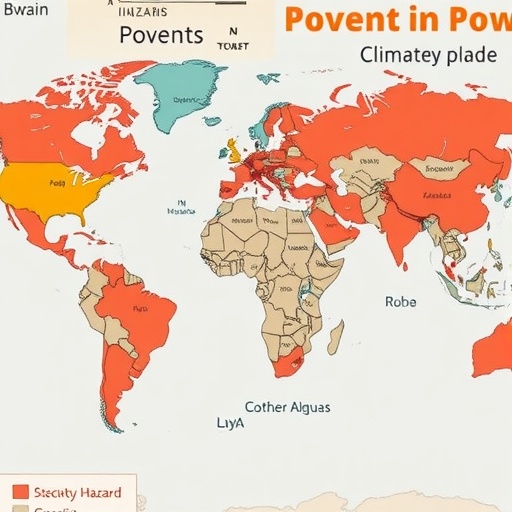In a landmark intersection of climate science and poverty studies, new research from the 2025 Global Multidimensional Poverty Index (MPI) delivers a stark warning: nearly 80 percent of those living in multidimensional poverty—an estimated 887 million out of 1.1 billion globally—are currently exposed to at least one severe climate hazard. These hazards include extreme heat, flooding, drought, and air pollution, marking a critical pivot in understanding how climate change exacerbates poverty beyond isolated economic deprivation, deeply entrenching socio-environmental vulnerabilities in the world’s poorest populations.
This comprehensive study, released just in time for the COP30 climate summit in Brazil, harnesses an innovative methodology by overlaying multidimensional poverty data across health, education, and living standards with geospatial climate hazard projections for the first time. The findings redefine poverty not merely as a social or economic issue but as a complex, multidimensional crisis entwined with planetary environmental destabilization. This fundamental insight calls for a paradigm shift in development policies, emphasizing climate resilience as an inseparable component of global poverty alleviation efforts.
Among the 1.1 billion individuals living in acute multidimensional poverty, the research highlights that a staggering 651 million face concurrent exposure to two or more climate hazards, while 309 million endure a triple or even quadruple burden of overlapping environmental shocks. Such simultaneous threats diminish adaptive capacities dramatically, often in contexts where asset ownership is minimal and social protection systems are woefully inadequate, thereby compounding the adversity faced by those in poverty.
The most pervasive climate hazards impacting impoverished populations globally are elevated ambient temperatures and hazardous air pollution levels, affecting 608 million and 577 million people respectively. These forces, individually and in concert, inflict chronic health stress, reduce labor productivity, and intensify energy insecurity. Flooding also poses a serious risk to 465 million poor individuals, while 207 million contend with drought conditions—highlighting the multifaceted nature of climate impacts which together undermine progress toward sustainable development goals.
Geographical analysis reveals that South Asia and Sub-Saharan Africa are the epicenters of this dual challenge. Together, these regions harbor 724 million poor people exposed to climate hazards, with South Asia alone accounting for 380 million, nearly all facing one or more climate threats. The near-universal exposure (99.1%) of poor populations in South Asia to such risks, especially the 91.6% confronting multiple hazards simultaneously, underscores the urgent need for integrated climate and development policies in these critical zones of vulnerability.
Notably, lower-middle-income countries bear a disproportionate burden, harboring 548 million poor individuals exposed to at least one climate hazard—over 60% of the global total. These countries reflect a complex socio-economic reality where development gains are at risk of reversal under relentless environmental strains. Among them, more than 470 million poor people grapple with multiple simultaneous climate hazards, pointing to the precarious balance between economic growth and ecological sustainability.
Projections into the latter part of the 21st century signal a troubling intensification of this inequity. Temperature projections indicate that countries currently experiencing high levels of multidimensional poverty will likely undergo the most severe temperature increases, magnifying the systemic risks faced by vulnerable populations. This trajectory threatens to stall or even reverse hard-won development advances, emphasizing the need for urgent, targeted intervention to bolster climate adaptation and resilience mechanisms specifically tailored for impoverished communities.
Experts emphasize that this research is not just descriptive but prescriptive. The integration of climate hazard data with poverty metrics opens pathways for developing climate-resilient poverty reduction strategies. Such strategies must move beyond mere recognition of these vulnerabilities to practical implementation, fostering strengthened local governance, adaptive infrastructure, and social safety nets capable of mitigating the compounded hazards identified.
International cooperation and financial redistribution are also critical elements highlighted by the findings. Financing mechanisms that account for the intersecting burdens of poverty and climate risks can enable more equitable global support frameworks. These frameworks would empower afflicted nations and communities to adopt innovative technologies, enhance early warning systems, and implement sustainable land and water management practices geared toward climate resilience.
The interrelationship between environmental burden and socio-economic disadvantage exposes the limits of traditional poverty metrics and climate assessments when considered in isolation. The multidimensional approach employed here captures the complex reality of lived experiences under climate stress, offering a more nuanced view of vulnerability and resilience. This refined understanding equips policymakers with robust data to tailor interventions at local, national, and global scales.
Furthermore, the systemic interaction between climate hazards and poverty challenges the scientific community to deepen interdisciplinary collaborations. Climatologists, sociologists, economists, and development practitioners must collectively refine predictive models and resilience frameworks to ensure inclusive and effective responses that prioritize human well-being alongside planetary health.
As the COP30 summit convenes, this report injects critical evidence into the global discourse on climate and sustainable development. It calls on world leaders to align climate pledges with poverty reduction commitments explicitly, ensuring that the most vulnerable will not be left behind in the pursuit of a stable, equitable future. The findings demand a unified agenda combining mitigation, adaptation, and social justice to navigate the inseparable crises of climate change and multidimensional poverty.
In conclusion, this pioneering research highlights how poverty and climate hazards are mutually reinforcing crises requiring holistic global action. Recognizing and addressing the overlapping hardships faced by the world’s poorest populations will be paramount to steering the planet toward a resilient, inclusive future where economic development and environmental sustainability coalesce for the benefit of all humanity.
Subject of Research: The intersection of multidimensional poverty and exposure to concurrent climate hazards globally
Article Title: Overlapping Hardships: The Dual Crisis of Poverty and Climate Hazards in 2025
News Publication Date: 17 October 2025
Web References:
- 2025 Global Multidimensional Poverty Index (MPI) – https://ophi.org.uk/global-mpi-2025
- United Nations Development Programme (UNDP) – https://undp.org
Keywords:
Climate change, climate data, poverty, multidimensional poverty, climate hazards, extreme heat, flooding, drought, air pollution, climate resilience, sustainable development, South Asia, Sub-Saharan Africa




